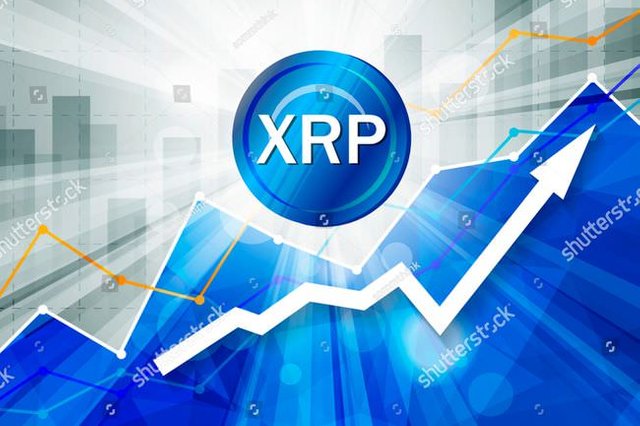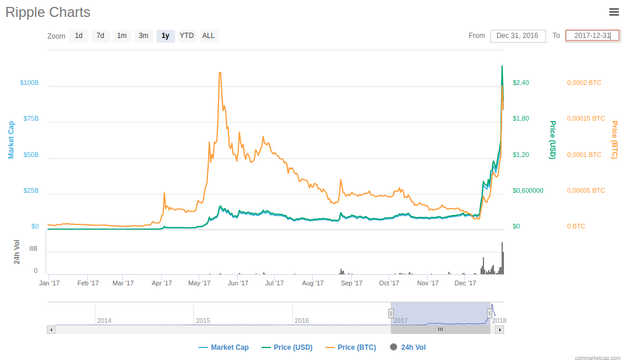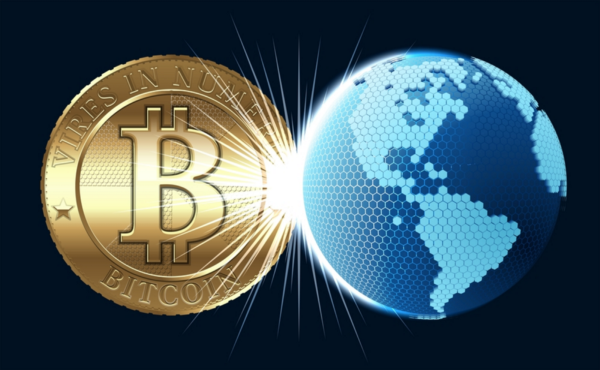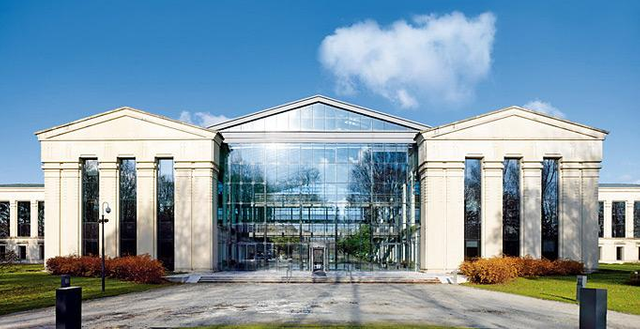Five cautions about Ripple
In the world of crypto investments news and misinformation so it is very important to open the true situation for all those who want to become a part of this marvelous new world prosper.

You heard news. Ripple took the second place on capitalization volume among all cryptocurrencies recently — this figure reached impressive 147 billion US dollars. Its cost was more Uber, Airbnb and Slack combined. In 2017 Ripple has shown the best results from all cryptocurrencies: his course has grown by impressive 36 thousand percent since the beginning of year!

Definitely, affairs at Ripple develop in the best way. And for those who for years invested in this cryptocurrency such news didn't become a surprise. In an interval from 2012 to 2016 Ripple has attracted 93,6 million dollars from Andrissen Horovitz, GV (Google Ventures) and many other large venture companies from Silicon Valley. These are those firms that routinely invest money in such startups as Facebook, Slack and Uber when they only begin to develop. Support of Ripple from their party means that they believe in the team of developers and their mission.
Besides, Ripple isn't bad presented on the Internet — is heard about him literally from each corner. Successful pilot programs, cooperation with more than 100 financial organizations, and even support of the Japanese government.
Everything goes just perfectly. Before us a classical example of the company with innovative technology which, as according to the textbook, takes the market by storm. And it would be the truth if not some fine details which actually have huge value.
1. XRP is not Ripple
When people hear the word Ripple, they think of XRP token at once. In it there is a sense, other communities are inseparably linked with the crypto tokens. When you buy ETH, you invest in Ethereum, and buying BTC, you stake on Bitcoin. So why to this logic not to work also in a case with Ripple?
And here we face something interesting. To understand a difference between XRP and Ripple, it is necessary to consider the Ripple company first of all.
It has been founded in 2012 under the name Opencoin, then in 2015 is renamed into Ripple. The head office of the company is located in San Francisco, more than 150 employees work there, and they are engaged in sales of the banking software using a blockchain.

What does Ripple? They have three products — xCurrent, xRapid and xVia.
xCurrent is their flagman offer. He gives to banks an opportunity to effectively move money through national borders. He uses RippleNet — Ripple blockchain — but doesn't use XRP. Banks love this product as it allows them to reduce considerably expenses and time expenditure when sending payments — and it without excess risk and need to make big changes to working process.
xRapid helps banks to improve liquidity at trade in emerging markets. It is the only product of Ripple using XRP. This product attracts banks, exempting them from need to sit on the mountains of money, but has the shortcomings consisting in volatility of XRP.
xVia still is in development and has to enter the market at the beginning of 2018. He is similar to xCurrent, but allows to send payments not only to banks, but also both the usual companies and suppliers of payment services. xVia will also not use XRP token.
Do all of you still remember that impressive list from more than hundred financial organizations, working with Ripple? And so, all of them use xCurrent. And xCurrent, we will remind, doesn't use XRP. From all clients who Ripple have for today only one uses XRP cryptocurrency - it is the small "non-bank finance company" from Mexico under the name Cuallix working with xRapid.
Thus, Ripple as the company really succeeds in cooperation with increasing number of banks — but it has no relation to XRP acceptance.
It doesn't mean that banks will never accept xRapid (and won't begin to use XRP). Actually, the business plan of Ripple from the very beginning was in "placing" banks on xCurrent and then to sell them xRapid. So banks, perhaps, will fall in love with xRapid.
And maybe, will also not fall in love. For Ripple there is practically no difference. And here for those who have invested money in XRP it is a matter of life and death.
2. XRP is not currency of the future

When people hear about bitcoin, they think of digital money — those which can be sent to any point of the world without any restrictions.
XRP can also come to it in the future, but now this token is ground only under banking. And Ripple did not report about any plans for change of a status quo yet.
In it there is nothing bad, moreover, the Ripple company, having focused only on banks and financial institutions, has huge potential and is very attractive to investors. The problem is that people who will decide that it can bypass bitcoin can begin to buy a token of XRP, replace fiatny money and to become world currency. In this case a market capitalization of XRP will be artificially uprated then the strong correction as soon as the real entity of XRP reveals all will follow.
Considering that Ripple is guided by global interbank payments, their real purpose is changeover of SWIFT — 45-year system responsible for relocation of money between banks from the different countries. In 2016 SWIFT received 31 million dollars of profit, having sent a huge number of money through the system. And nevertheless this digit is very small in comparing by the total amount of monetary assets in a pattern — more than 1 trillion US dollars. This restriction with only one SWIFT market considerably reduces the capacity of XRP as real world digital currency.
3. XRP — not new technology
Ripple — not the single company trying to revolutionize the banking sphere.
So, R3 is engaged in the same, as Ripple. This company using a blockchain for relocation of money between banks could receive 107 million dollars of the venture capital. For today she cooperates with 70 largest banks of the world — but very few people heard about her only because they have no own token.
SWIFT works with more than 11 thousand financial institutions and totals more than 2600 employees. To capture this market, Ripple it is necessary to grow a hundred times. The principal complexity is here that nothing hinders SWIFT to develop own technology of a blockchain and to use the already established business contacts to roll out it one market quicker than Ripple.

Whether so will develop SWIFT own blockchain? The head of department of banking activities of SWIFT Harry Newman looks unperturbable. It considers a blockchain just as new technology which can be built in the existing systems if its advantages outweigh shortcomings.
"If we see a sense in embedding it in our system of global payments, we will make it. That is why I do not see any break in technology of a blockchain. I consider it as constructive technology which can be studied and put into practice".
And their actions correspond to their words. SWIFT tested Hyperledger Fabric blockchain with 22 banks, having released their capital which is stored on accounts of nostro. They also made experiments with smart contracts. Perhaps, all of us should invest in SWIFT token if they solve it to release?
Stellar Lumens (XLM) was created in 2014 by the founder of Ripple Jed Makkaleb with the purpose to solve problems which Ripple faced.
Since then Stellar reached the eighth place on a market capitalization among crypto tokens and can brag of the concluded contracts with IBM and payment service providers from Australia, Indonesia, Malaysia and Korea.
As Stellar works not only with banks, its potential is much higher than Ripple. And the Stellar protocol supports smart contracts — a key component of the popular Ethereum network. Kik — the application messenger which collected hundreds of millions dollars during ICO and made the decision to transfer the tokens (KIN) from Ethereum on Stellar in 2018 became one of the last victories of Stellar on this front.
4. XRP isn't decentralized
Ripple controls RippleNet and the impressive 62% of all existing XRP tokens own. Of course, it strongly disturbed investors in XRP, and Ripple has promised to store 55 billion tokens on an eskroa. As well as in any centralized system, investors should believe that Ripple will keep the word.
And most likely she really will constrain him. Considering the sounded policy on release of 1 billion tokens in a month within the next 55 months, the company will receive a huge number of money, having sold these 55 billion XRP at the current market price.
But risks of centralization are beyond simple trust of Ripple. A problem is also stability. The reason for which digital currencies of the past didn't manage to reach anything is that the centralized digital currency it is possible to kill easily by means of state regulation. Decentralization of Bitcoin — one of the key reasons why it could endure the predecessors from two-thousand (E-gold, Liberty Reserve, Tencent and many others).
Ripple has the same shortcoming, as all early digital currencies. It is one legal entity which it is possible to blame if something goes not so.
5. Acceptance of XRP doesn't mean growth of its cost
Let's present that everything will go according to the plan. Ripple works with about tens of thousands of banks, they like to use a blockchain and xCurrent and decide to try to work with XRP through xRapid. This product is pleasant to them, and they are taken confidence completely to pass to carrying out transactions in him. SWIFT lags behind and can't cope with innovations, finally losing all clients and being closed.
You are happy. Daily by means of XRP transactions for the sum more than 5 billion dollars are carried out. The price of XRP has to depart to the Moon, the truth? Well, optional.
Growth of the course XRP is warmed up by the people having these tokens in the asset and believing that they will cost more in the future. Banks just want to move money between the different countries, but not to be engaged in speculation. They in principle aren't interested in keeping XRP, putting at themselves at risks because of volatility of a token.
It means that banks will try to get rid of XRP as fast as possible. And considering the speed of network functioning of Ripple, on it no more than 4 seconds will leave. As banks — the main users of XRP — will long not store the tokens, market capitalization of XRP will decrease and even at the most favorable scenario when Ripple wins against SWIFT and will take all market, will make only about 230 million dollars. Compare it to the current speculative capitalization — 128 billion dollars.
Follow, Resteem and VOTE UP @keks blogger of https://steemit.com and always I hope for your help. |
|---|


Thank you for the information, it is really helpful to understand another perspective for the ripple effect.
My predictions if Ripple will be $100 or $1000 one day! Also, don't forget, that you can be easily rapped by Ripple!
Wow.....very insightful post and well detailed.I have this urge to start investing in ripple but dont really know to go about it.I need assistance
Thanks, in network many exchangers exists on which it is possible to buy this coin.
This post is really in depth and also helped me understand the Ripple projects without having to search through many, many websites and lots of content. Definitely resteemed, upvoted,and followed!!
@shredz7
Coins mentioned in post: